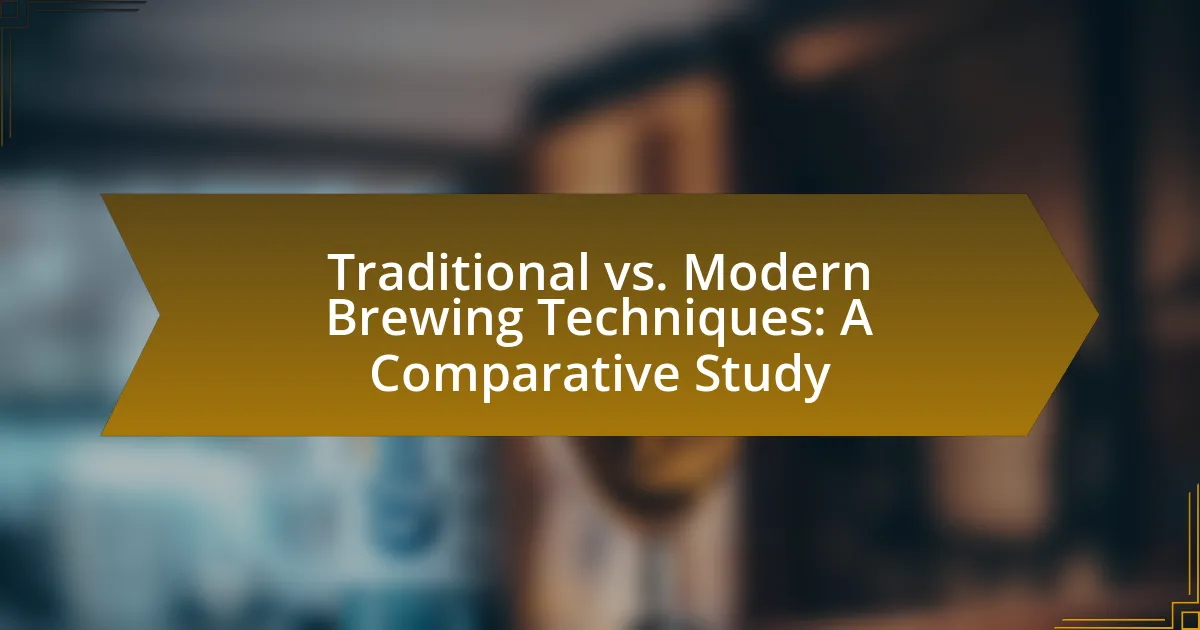Temperature control plays a critical role in fermentation, directly influencing yeast and bacterial activity, metabolic processes, and the overall quality of fermented products. Maintaining optimal temperature ranges is essential for efficient sugar conversion into alcohol and carbon dioxide, which affects flavor and aroma development. The article outlines the key temperature ranges for various fermentation types, the consequences of improper temperature management, and the technologies and methods used for effective temperature control. Additionally, it discusses best practices for maintaining consistent fermentation temperatures and practical tips for home brewers to enhance their fermentation processes. Understanding these factors is vital for achieving desired flavor profiles and ensuring high-quality outcomes in fermentation.

What is the role of temperature control in fermentation?
Temperature control in fermentation is crucial for optimizing yeast activity and metabolic processes. Maintaining specific temperature ranges ensures that yeast can efficiently convert sugars into alcohol and carbon dioxide, which is essential for producing desired flavors and aromas in fermented products. For instance, temperatures that are too high can lead to the production of unwanted byproducts, while temperatures that are too low can slow down fermentation rates, potentially leading to incomplete fermentation. Studies have shown that optimal fermentation temperatures vary by yeast strain; for example, ale yeast typically ferments best between 18-22°C, while lager yeast prefers cooler temperatures around 7-13°C. This precise temperature management directly influences the quality and consistency of the final product.
How does temperature influence the fermentation process?
Temperature significantly influences the fermentation process by affecting the metabolic activity of yeast and bacteria. Higher temperatures generally accelerate fermentation rates, as they increase the activity of microorganisms, leading to faster production of alcohol and carbon dioxide. However, excessively high temperatures can inhibit yeast activity or produce undesirable byproducts, such as off-flavors. Conversely, lower temperatures slow down fermentation, which can enhance flavor development but prolong the process. Research indicates that optimal fermentation temperatures for yeast, such as Saccharomyces cerevisiae, typically range from 20°C to 30°C, where the yeast performs efficiently without producing harmful compounds.
What are the key temperature ranges for different fermentation types?
The key temperature ranges for different fermentation types are as follows: for alcoholic fermentation, the optimal range is typically between 20°C to 30°C; for lactic acid fermentation, the range is generally between 30°C to 40°C; and for acetic acid fermentation, the ideal temperature is around 25°C to 30°C. These ranges are crucial as they influence the metabolic activity of microorganisms involved in fermentation, affecting the flavor, aroma, and overall quality of the final product. For instance, yeast used in alcoholic fermentation, such as Saccharomyces cerevisiae, thrives best at temperatures around 25°C, which promotes efficient sugar conversion to alcohol.
How does temperature affect yeast and bacteria activity during fermentation?
Temperature significantly influences yeast and bacteria activity during fermentation. Optimal temperatures, typically between 20°C to 30°C for yeast and 30°C to 40°C for bacteria, enhance metabolic rates, leading to efficient fermentation processes. At these temperatures, yeast cells actively convert sugars into alcohol and carbon dioxide, while bacteria effectively produce lactic acid or other metabolites. Conversely, temperatures below the optimal range slow down metabolic activity, resulting in sluggish fermentation, while excessively high temperatures can denature enzymes and kill the microorganisms, halting fermentation altogether. Studies have shown that maintaining precise temperature control can improve fermentation efficiency and product quality, underscoring the critical role of temperature in microbial activity during fermentation.
Why is temperature control critical in fermentation?
Temperature control is critical in fermentation because it directly influences the metabolic activity of microorganisms involved in the process. Maintaining an optimal temperature range ensures that yeast and bacteria can efficiently convert sugars into alcohol, acids, and gases, which are essential for producing desired flavors and characteristics in fermented products. For instance, yeast fermentation typically occurs best between 20°C and 30°C; temperatures outside this range can lead to sluggish fermentation or the production of off-flavors. Studies have shown that temperature fluctuations can also affect the growth rates and viability of these microorganisms, ultimately impacting the quality and consistency of the final product.
What are the consequences of improper temperature management?
Improper temperature management during fermentation can lead to several negative consequences, including the production of off-flavors, reduced fermentation efficiency, and potential spoilage of the product. For instance, temperatures that are too high can cause yeast to produce undesirable compounds such as fusel alcohols and esters, which negatively affect the flavor profile. Conversely, temperatures that are too low can slow down yeast activity, leading to incomplete fermentation and residual sugars, which can result in a sweet and unbalanced final product. Additionally, improper temperature control can promote the growth of unwanted microorganisms, leading to spoilage and contamination. Studies have shown that maintaining optimal fermentation temperatures is crucial for achieving desired flavor characteristics and overall product quality.
How does temperature control impact the flavor profile of fermented products?
Temperature control significantly impacts the flavor profile of fermented products by influencing the metabolic activity of microorganisms involved in fermentation. Different temperatures can enhance or inhibit the growth of specific yeast and bacteria, which in turn affects the production of flavor compounds such as esters, phenols, and organic acids. For instance, higher fermentation temperatures often lead to increased ester production, resulting in fruity flavors, while lower temperatures can promote the development of cleaner, more subtle flavors. Research indicates that optimal temperature ranges for fermentation vary by product; for example, wine fermentation typically occurs between 18-24°C, where the balance of flavor compounds is maximized. This precise temperature management is crucial for achieving desired flavor characteristics in products like beer, yogurt, and sauerkraut.

What methods are used for temperature control in fermentation?
Temperature control in fermentation is primarily achieved through methods such as cooling jackets, temperature-controlled fermentation vessels, and ambient temperature regulation. Cooling jackets are external systems that circulate coolant around fermentation tanks, maintaining a consistent temperature. Temperature-controlled fermentation vessels are equipped with built-in heating and cooling systems that allow precise adjustments to the fermentation environment. Ambient temperature regulation involves controlling the surrounding environment, such as using insulated rooms or climate-controlled spaces, to ensure optimal fermentation conditions. These methods are essential for maintaining yeast activity and product quality, as temperature fluctuations can adversely affect fermentation rates and flavor profiles.
How do different fermentation vessels contribute to temperature regulation?
Different fermentation vessels contribute to temperature regulation by varying their thermal mass and insulation properties. For instance, stainless steel fermenters have high thermal conductivity, allowing for rapid heat exchange, which can lead to quicker temperature adjustments. In contrast, glass carboys provide less thermal insulation, resulting in slower temperature changes, which can be beneficial for maintaining stable fermentation conditions. Additionally, the size and shape of the vessel influence how heat is distributed; larger vessels tend to retain heat longer due to their greater thermal mass. Research indicates that controlling fermentation temperature is crucial for yeast activity and flavor development, emphasizing the importance of vessel selection in achieving desired fermentation outcomes.
What are the advantages of using insulated fermentation tanks?
Insulated fermentation tanks provide enhanced temperature control, which is crucial for optimizing fermentation processes. By maintaining a stable temperature, these tanks reduce the risk of temperature fluctuations that can negatively affect yeast activity and fermentation efficiency. Studies indicate that consistent temperatures can lead to improved flavor profiles and higher quality products, as yeast performs best within specific temperature ranges. Additionally, insulated tanks minimize energy consumption by reducing the need for external heating or cooling systems, leading to cost savings in production.
How does the material of fermentation vessels affect temperature stability?
The material of fermentation vessels significantly affects temperature stability by influencing heat retention and dissipation. For instance, stainless steel vessels provide excellent thermal conductivity, allowing for rapid temperature adjustments, while glass vessels have lower thermal conductivity, resulting in slower temperature changes. Additionally, materials like plastic can insulate poorly, leading to greater temperature fluctuations. Research indicates that the choice of vessel material can impact fermentation efficiency and product quality, as temperature stability is crucial for optimal yeast activity and metabolic processes.
What technologies are available for monitoring and controlling fermentation temperature?
Technologies available for monitoring and controlling fermentation temperature include temperature sensors, thermostats, and automated fermentation control systems. Temperature sensors, such as thermocouples and resistance temperature detectors (RTDs), provide real-time data on fermentation conditions. Thermostats can regulate heating or cooling systems to maintain desired temperature ranges. Automated fermentation control systems integrate sensors and control mechanisms to optimize temperature throughout the fermentation process, enhancing product consistency and quality. These technologies are essential for achieving precise temperature control, which is critical for yeast activity and overall fermentation efficiency.
How do digital temperature controllers work in fermentation?
Digital temperature controllers in fermentation regulate the temperature by continuously monitoring and adjusting the heating or cooling systems based on preset temperature parameters. These controllers utilize sensors to detect the current temperature of the fermentation environment and compare it to the desired setpoint. When the temperature deviates from the setpoint, the controller activates heating or cooling mechanisms to maintain the optimal fermentation temperature, which is crucial for yeast activity and product quality. Studies have shown that maintaining specific temperature ranges can significantly influence fermentation rates and the flavor profile of the final product, underscoring the importance of precise temperature control in fermentation processes.
What role do thermocouples and temperature sensors play in fermentation?
Thermocouples and temperature sensors are critical in fermentation as they provide accurate temperature measurements essential for controlling the fermentation process. Maintaining optimal temperature ranges is vital for yeast activity and metabolic processes, which directly influence the quality and characteristics of the final product. For instance, specific temperature ranges can enhance fermentation efficiency and flavor profiles in beverages like beer and wine. Studies have shown that deviations from ideal temperatures can lead to off-flavors and reduced fermentation rates, underscoring the importance of precise temperature monitoring through these devices.

What are the best practices for maintaining optimal fermentation temperatures?
The best practices for maintaining optimal fermentation temperatures include closely monitoring temperature levels, using temperature-controlled fermentation vessels, and adjusting environmental conditions as needed. Monitoring temperature with precise thermometers ensures that fermentation occurs within the ideal range for the specific yeast or bacteria being used, typically between 65°F to 75°F for ales and 45°F to 55°F for lagers. Utilizing temperature-controlled fermentation vessels, such as jacketed fermenters or fermentation chambers, allows for consistent temperature regulation, preventing fluctuations that can stress yeast and lead to off-flavors. Additionally, adjusting environmental conditions, such as using cooling jackets or heat wraps, can help maintain the desired temperature throughout the fermentation process. These practices are supported by research indicating that temperature stability is crucial for yeast health and fermentation efficiency, ultimately impacting the quality of the final product.
How can brewers and fermenters ensure consistent temperature control?
Brewers and fermenters can ensure consistent temperature control by utilizing temperature-controlled fermentation vessels equipped with precise thermostats and monitoring systems. These vessels maintain the desired temperature range throughout the fermentation process, which is crucial for yeast activity and flavor development. Research indicates that maintaining a stable fermentation temperature can reduce off-flavors and improve the overall quality of the final product. For example, a study published in the Journal of the American Society of Brewing Chemists found that fluctuations in temperature during fermentation can lead to undesirable esters and phenols, negatively impacting beer flavor. Therefore, implementing advanced temperature control technologies is essential for achieving consistency in brewing and fermentation processes.
What are the common troubleshooting steps for temperature fluctuations during fermentation?
To address temperature fluctuations during fermentation, the common troubleshooting steps include monitoring the fermentation environment, adjusting the temperature control system, and insulating the fermentation vessel. Monitoring involves regularly checking the temperature with a reliable thermometer to ensure it remains within the optimal range for the specific fermentation process. Adjusting the temperature control system may involve recalibrating thermostats or modifying heating/cooling settings to stabilize the temperature. Insulating the fermentation vessel can help maintain a consistent temperature by reducing external temperature influences. These steps are essential as temperature stability is crucial for yeast activity and overall fermentation success.
How can one effectively adjust temperature during different fermentation stages?
To effectively adjust temperature during different fermentation stages, one should utilize controlled heating or cooling systems, such as temperature-controlled fermentation tanks or water baths. These systems allow precise temperature management, which is crucial as different fermentation stages require specific temperature ranges to optimize yeast activity and metabolic processes. For instance, primary fermentation typically occurs best between 20°C to 25°C, while secondary fermentation may benefit from cooler temperatures around 15°C to 20°C to enhance flavor development and clarity. Studies have shown that maintaining these temperature ranges can significantly impact the final product’s quality, as yeast performance and byproduct formation are highly temperature-dependent.
What practical tips can enhance temperature control in fermentation?
To enhance temperature control in fermentation, utilize insulated fermentation vessels to maintain stable temperatures. Insulation minimizes temperature fluctuations caused by external environmental changes, ensuring a consistent fermentation process. Additionally, employing temperature monitoring devices, such as thermocouples or digital thermometers, allows for real-time tracking of fermentation temperatures, enabling timely adjustments. Research indicates that maintaining optimal fermentation temperatures can significantly improve yeast activity and product quality, as yeast performance is highly sensitive to temperature variations.
What are the recommended tools for home brewers to monitor fermentation temperature?
Home brewers are recommended to use digital thermometers, temperature controllers, and fermentation chambers to monitor fermentation temperature effectively. Digital thermometers provide accurate readings and quick response times, allowing brewers to track temperature changes closely. Temperature controllers can automate the heating or cooling process, maintaining a consistent environment for fermentation. Fermentation chambers, which can be temperature-regulated, offer a controlled space that minimizes external temperature fluctuations, ensuring optimal fermentation conditions. These tools collectively enhance the precision of temperature management, which is crucial for producing high-quality beer.
How can one create a stable fermentation environment in varying climates?
To create a stable fermentation environment in varying climates, one should utilize temperature control methods such as insulated fermentation vessels, temperature-regulated rooms, and water baths. Insulated vessels help maintain a consistent internal temperature despite external fluctuations, while temperature-regulated rooms can be equipped with heating or cooling systems to adjust the ambient temperature. Water baths provide an additional layer of temperature stability by surrounding fermentation vessels with water that absorbs and moderates temperature changes. Research indicates that maintaining fermentation temperatures within a specific range, typically between 20°C to 25°C for many yeast strains, enhances fermentation efficiency and product quality.










































